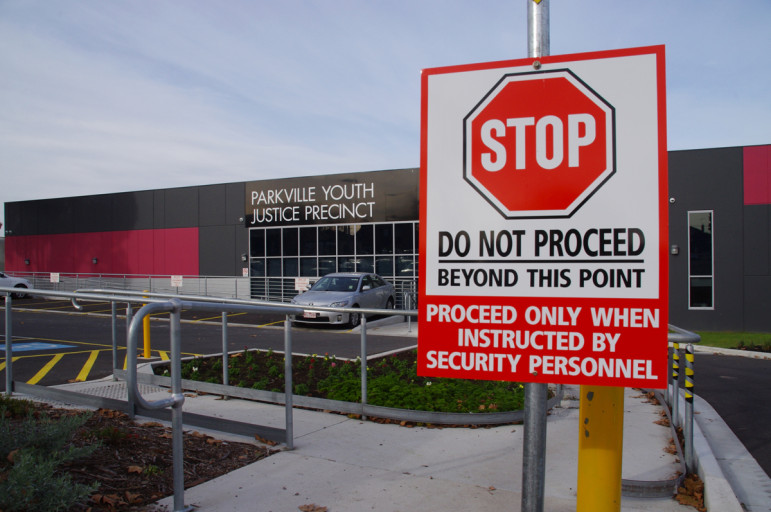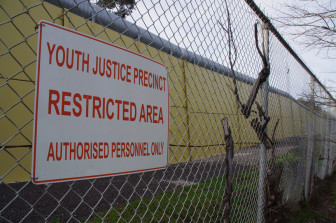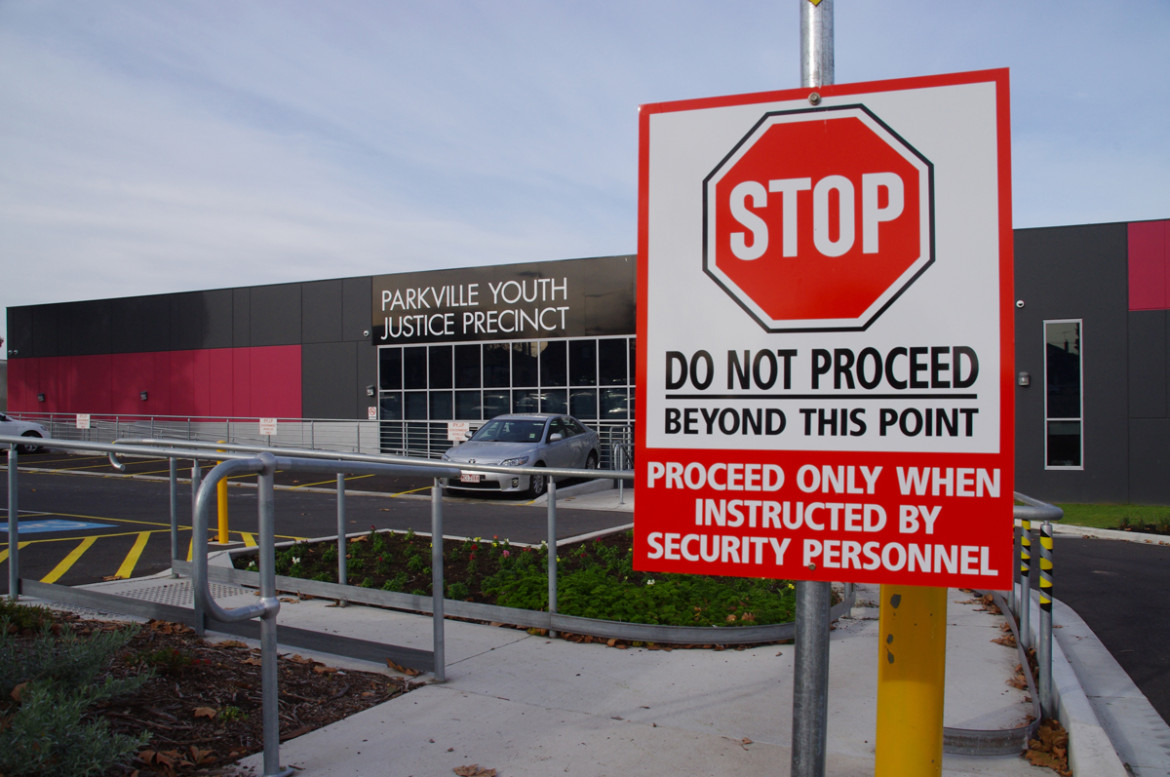Bored and angry kids are taking to violent crime in increasing numbers and, once caught, they are ever more likely to re-offend. In the search for answers, education and employment are showing signs of helping to break the pattern.

Daniel McCulloch
Parkville Youth Justice Precinct in Melbourne, Australia.
MELBOURNE, Australia-- There’s no way to tell him apart from any other young guy crammed into the fast-food restaurant. Tradesmen have descended in droves, and the race is on to order before the breakfast menu expires. In a high-visibility work jacket, he blends into the sea of yellow and orange.
Bleary-eyed after a late night at work, he wears a thick, black beanie and a hooded jumper, the color of his favorite basketball team, under his uniform. We are standing shoulder-to-shoulder at the back of a snaking line to the counter when he introduces himself in a low voice, almost mumbling.
His name is Peter, he is 20 years old, and he was recently released from Malmsbury Youth Justice Centre.
By the time Peter, who does not want his surname published, dropped out in year 10, he had been in and out of five schools. “I was bored, angry, frustrated and stressed out,” he says.
He had a string of casual jobs, but Peter says he was much more interested in going out drinking. He and his friends started getting into trouble, attracting police attention. Brawls and stabbings became commonplace and escalated into serious criminal offending. In March, Peter finished an eight-month sentence for armed robbery.
Young Victorians, many not yet teenagers, are committing crime at unprecedented rates. Australian Institute of Criminology research reveals offending by children aged 10 to 14 rose 12 percent between 2008-09 and 2009-10, reaching a record high.
Over the past decade, young offenders have shifted away from property crime, instead committing more violent, aggressive crimes against people. According to Jesuit Social Services data, the greatest proportional increase is among those younger than 13.
“You see little shits like that running around everywhere,” Peter says. “They’re still kids; they haven’t even grown up yet. They have that mentality of thinking they’re invincible. They start trying to be fearless, acting up again and again, even after they get caught.”
Youth worker Les Twentyman hears horror stories about crimes by children almost every day:
- A small child scales the wall of a suburban house before squeezing through an open window; his parents, waiting below, are ready to attempt the first of several burglaries planned for the night.
- A teenager’s mentally ill father is fighting another man. The 14-year-old rushes to his dad’s defense, bludgeoning the attacker to death with a metal pole.
- An eight-year-old watches as his father brutally kills two people. Years later, he too is imprisoned for murder.
Once children this age are embroiled in crime, Victoria Police research suggests they are increasingly likely to reoffend. Between 2000 and 2007, the number of repeat offenders aged 10 to 14, as a percentage of all offenders in that age group, climbed rapidly.
The statistics are striking, but the reasons for this rise in offending and the shift towards violent crime are unclear. For those at the coalface of the youth justice system, there is no simple solution.
At Youthlaw - a legal rights center for young people - advocacy and human rights officer Tiffany Overall says it’s often the most vulnerable children who are coming into contact with the justice system at a young age.
“If you happen to be growing up in a number of highly disadvantaged postcodes, you’ve got a much greater likelihood of finding yourself in a situation of offending behavior,” Overall says.
Almost two in five young offenders in detention or under community supervision in Australia are from the most disadvantaged areas of communities, according to the Australian Institute of Health and Welfare (AIHW).
AIHW statistics reveal children from the areas of lowest socioeconomic status are five times more likely to be under supervision than those from the areas of highest status.
Twentyman says another major factor driving youth crime is family violence and breakdown. “You only have to go to the Children’s Court to see kids that are taken from families because of dysfunctional and drug-dependent parents,” he says. “The situation sets them up to become very agitated, stressed and quite fragile.”
Twentyman says this situation is made worse by a range of factors, including peer pressure, poor educational engagement, drug use and gang culture.
“When these issues collide, it starts to become a pretty bleak picture for these young people,” he says. “Quite often, these kids transform into the offenders of tomorrow.”
About 7,000 young offenders are either in detention or under community supervision on an average night in Australia. Victoria has the nation’s lowest per capita rates of both.

Daniel McCulloch
Parkville Youth Justice Precinct in Melbourne, Australia.
Most young Victorians given a custodial sentence in Children’s Court are sent to the Parkville Youth Justice Precinct. It is the state’s highest security youth justice center. Offenders at Malmsbury Youth Justice Centre, about 100km north-west of Melbourne, are usually dealt with in adult court. Sentenced in the Magistrates’, County or Supreme courts, these offenders are placed into youth detention because of their age.
Sentencing Advisory Council chairman Professor Arie Freiberg would not detail the council’s official stance on sanctioning children, but says jailing young offenders is an option of “absolute last resort” in Victoria.
“Very, very rarely in Victoria do crimes by extremely young offenders result in incarceration,” Freiberg says.
Ian Lanyon, director of secure services for the Department of Human Services, says because of this sentencing philosophy, children ending up in custody are “very much at the pointy end of the spectrum”.
Between 80 and 90 percent of children at the Parkville Youth Justice Precinct have committed crimes against people.
“They are serious offenders who have committed some heinous crimes,” Lanyon says. “Their charges span from murder and manslaughter to rape and armed robbery.”
“There’s a perception youth custody is a holiday, but this is no country club. Some people think we’re soft on kids, but that’s certainly not the case.”
At the Parkville precinct, youth workers take the place of prison guards. Key workers are each assigned a cluster of “clients.” They provide a constant presence from the moment these children wake up in the morning until they go to bed.
Lanyon says most of these young people come from backgrounds of significant trauma, including deprivation and abuse.
“Understanding their behaviors through this lens, we need to respond accordingly; recognizing there are triggers for these young people, and what those triggers are,” he says.
When clients misbehave, consequences are immediate and assertive, but not punitive.
“If we meet heightened behavior with heightened behavior, it will exacerbate the situation and reinforce the child’s actions,” he says.
Security at the precinct is strict. The complex is bordered by 15-meter walls (almost 50 feet) crowned with barbed wire. Staff and visitors are subject to eye scans and metal detectors. Security staff conduct physical searches at their discretion. Behind the scenes, members of the Safety Emergency Response Team (SERT) monitor the entire precinct. Skilled negotiators, SERT members receive training from Victoria Police and Corrections Victoria in how to use force efficiently and effectively.

Daniel McCulloch
Parkville Youth Justice Precinct in Melbourne, Australia.
Accommodation at the precinct is bleak. Concrete walls, stark metal toilets and dreary views are features of each room. Of 87 juveniles housed at the Parkville precinct, eight boys are not yet 15. These children are separated from the wider population, housed in a tired, dilapidated section known as the Parkville Youth Residential Centre.
Across Australia, children aged 10 to 13 account for about 6 percent of those under supervision. This figure increases significantly when 14-year-olds are included.
“The idea of incarcerating a 10-year-old is pretty scary,” Lanyon says. “When they come in here at that age, it’s a big red flare to signal we must do something, so that they won’t continue on through the youth justice system into adult jails.”
“They’re at an age where I think we can get in there and have a positive impact.”
Lanyon says education is a crucial factor guiding the Victorian youth justice system’s approach to rehabilitating clients and reducing reoffending.
“Education is our centerpiece; it is at the heart of everything we do,” he says. “This doesn’t refer solely to literacy and numeracy, but to educating the whole person. It’s not just about sitting in a classroom for eight or nine hours a day, but also what happens before and after school back in the units.”
In addition to attending workshops on violence, anger management and drugs and alcohol, the clients attend classes at Parkville College, a self-contained school within the precinct, six days a week. They are assigned homework and set readings to complete every evening.
At Malmsbury, all youths are required to attend TAFE. For these 85 offenders, the focus is on building employment pathways.
“Education and employment are the best ways to curb recidivism,” Lanyon says.
Young offender Peter says education was a powerful aspect of his time in custody. “The programs you do inside youth justice change you. You’re a different person when you come out; you think differently, you act differently,” Peter says.
“I’m a better person now.”
With help from charity organizations Whitelion and 20th Man Fund, Peter will soon begin full-time work with one of Australia’s largest logistics companies.
Youthlaw’s Tiffany Overall says while incarceration may have a positive impact on some young people, she is disturbed by the lasting, damaging effects that contact with the criminal justice system has on others.
“Children are being labeled as troublemakers and stigmatized from a very young age, and often that’s really hard for a young person to break out of,” she says.
Overall cautions against looking solely at crime figures, stressing the importance of focusing on the issues driving youth offending.
“Unless some of those underlying risk factors are identified and addressed, nothing is really shifting or changing in these young people’s lives,” she says.
“In their minds, there’s nothing stopping them reoffending.”
Overall says the focus needs to be community engagement and family support.
The experts agree on one thing. Police intervention, in its current form, is not helping.
“The system is compounding these young kids’ vulnerabilities, in terms of how police are responding and the interventions they impose,” Overall says.
“Coming to police attention and being introduced to the criminal justice system is often likely to produce a response where kids continue to offend, rather than stop,” she says.
“Those that are coming before the system at an early age are more likely to commit multiple offenses, and go on with longer criminal careers.”
“There needs to be greater consistency, understanding and empathy from members of Victoria Police.”
Victoria Police public safety spokesperson Inspector Lisa Hardeman says training of recruits and members has become a key focus of the force’s youth strategy.
“Through the development of the center for ethics and community engagement, police receive training in cultural awareness, understanding adolescence and addressing recidivism,” Hardeman says.
Training also extends to understanding the benefits of diversion and developing community partnerships.
“We maintain a focus on cautioning, diversion and referral options for young people,” she says.
Youth worker Les Twentyman argues youth offending should not be considered an issue for police, but for welfare organizations.
“Instead of building more jails and employing more police and prison officers, we should be resourcing more youth workers to connect with these kids and give them a pathway out of criminal behavior.”
Twentyman says there should be outreach workers in every Victorian primary and secondary school.
“Crime is a cycle, and we need to get to the coalface, pull our sleeves up, and rip kids out of it,” he says.
“The more kids are able to keep out of the justice system, the better.”
Peter agrees. He pauses and pulls off his beanie, making sure our eyes meet before mentioning his son, who turns two in July.
“Your freedom is completely taken away inside detention; you lose a lot of your time, time you’ll never get back,” he says.
“I will never have that time with my son.”
“If you’re doing crime, or thinking about doing crime, stop. It’s not worth it. It’s just not.”
Daniel McCulloch is studying criminology and journalism at Monash University. He loves uncovering and breaking news with a strong human interest element and believes everybody has a story to tell.
Series Editor: Corinna Hente, editor of Monash University's journalism website, mojo.

